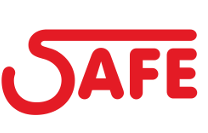South Africa’s Carbon Tax Bill is one of the critical pieces of legislation that will impact on the agribusiness environment.
This is the opinion of Agribiz CEO, Dr John Purchase writing in his 2017 agribusiness outlook.
And while primary agriculture will likely be exempt from being directly taxed during the first phase of the tax’s implementation, the SA fruit and wine initiative Confronting Climate Change (CCC) says “agriculture can expect to experience cost pressure on all key material and energy inputs including electricity, fuel, fertilisers and agrochemicals”.
During the second phase – expected to commence in 2020/21- “all Scope 1 emissions from agriculture will be taxable”, including mobile and stationary combustion, and fugitive emissions*.
In February, former Finance Minister Pravin Gordhan said SA’s proposed carbon tax and its implementation date would “be considered further in Parliament this year”. Although much of its nitty-gritty still needs to be fleshed out, analysts have cautioned South Africans to start preparing for the tax’s roll-out. Its implementation could see SA – regarded one of the world’s top 20 carbon dioxide emitters per capita – reduce its greenhouse gas emissions by 33% by 2035.
‘You have to have a starting point’
The first step is measuring farms’ carbon footprint. “You have to have a starting point,” says Christie Henn, Manager, Bonathaba (Wellington, Western Cape), one of the table grape and citrus farms managed by Cape Town-based producer and exporter SAFE (South African Fruit Exporters). “A good start is to find out what on your farm causes your carbon footprint to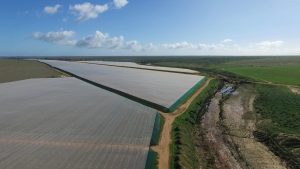 be the size it is and what you can use to offset it. This will guide your future steps in decreasing the footprint.”
be the size it is and what you can use to offset it. This will guide your future steps in decreasing the footprint.”
Bonathaba and neighbouring Zwartfontein – also a SAFE farm – use the CCC’s carbon calculator to determine their footprint. According to Dries van Rooyen, General Manager of Farming Operations, SAFE, both farms have been registered with Blue North, which supports agricultural businesses in implementing sustainability strategies. Certain managers and SAFE staff underwent training and have started to document the farms’ activities.
“We plan to register all SAFE’s farms within the next two years, so they can start measuring and monitoring their carbon footprint. We believe it’ll be a smooth integration, as many of the agricultural practices aimed at curbing global warming are daily and basic methods farmers have been applying for decades – unknowingly perhaps. These practices are now being refined,” says Van Rooyen.
Counting firmly in agriculture’s favour is the fact that farms, often sporting large amounts of planted hectares, are mostly carbon negative, i.e. they convert carbon dioxide into oxygen, says André Botha, Senior Agriculturalist, UFF African Agri Investments, from which SAFE rents farm land and infrastructure.
So, which sustainable practices have SAFE’s farms been implementing so far?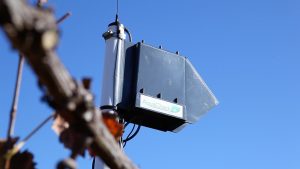
“We always try to take advantage of the latest technology to shrink our carbon footprint, such as irrigation-scheduling programmes,” says Henn. By using data gathered by weather stations and probes measuring the soil moisture content, SAFE monitors exactly how much water is needed, when, and then only dispenses the required quantities. This has eliminated excessive irrigation and led to a water consumption reduction of 18% to 20%. Irrigation pumps with variable speed drives further assist farmers in using less electricity.
SAFE’s pre-cooling systems operate with water side panels rather than gas compressors. As a result no gas is being emitted. Covering vineyards with nets helps to save water, as does pulling up old windbreaks which guzzle thousands of litres of water.
Making the co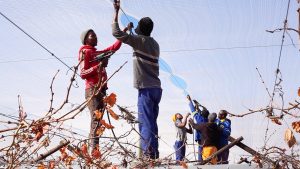 ld chain as short as possible
ld chain as short as possible
Pack houses and cold stores’ location plays a key role. “We try to install the majority of our production units in the most energy-efficient manner. All cold stores are adjacent or in close proximity to the pack houses, so farmers don’t have to transport their fruit elsewhere to be cooled down. Complete consignments – packed to the brim – travel from the farm to the harbour or final destination. We’re making the cold chain as short as possible,” explains Botha.
In addition, morning-shift teams pick SAFE’s table grapes between 4:00AM and 10:00AM, before the midday sun hits. When the grapes arrive at the pack house, their temperature is still low and they don’t need be cooled down, saving electricity.
Most of SAFE’s farm buildings are fitted with energy-efficient bulbs, roofs are isolated and Perspex roofs are used to let through natural light. New farmworker accommodation buildings and crèches are supplied with solar power, while older buildings’ electrical geysers are replaced with solar ones. “From Bonathaba’s electricity bill we can already see a huge improvement,” says Henn.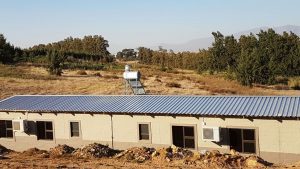
When SAFE purchases new vehicles or tractors, efficient diesel consumption is non-negotiable. “Two years ago we moved from 500 ppm to the environment-friendlier 50 ppm,” remarks Henn. Vehicles are serviced regularly and diesel consumption monitored continuously.
Pest control still ‘prickly pear’ for sustainable farmers
Pest control remains a “prickly pear” for sustainable farmers. Van Rooyen says SAFE now administers a “soft programme” instead of hard chemicals. “With the help of a brilliant pest-hotspot scouting programme, we only spray when absolutely necessary.”
When fertilising, SAFE believes it is crucial to first establish the soil’s condition, looking at nutrients and shortages – by taking leaf-soil samples and measuring micro and macro elements annually. “We don’t want to ‘over-fertilise’ or put back any unnatural elements – only exactly what’s needed,” he says.
Henn adds: “We aim to restore our soil’s structure through an annual composting programme. Offshoots are placed back in the vineyards where they turn into compost and nourish the soil organically.” SAFE also plants cover crops – known as “natural nitrogen manufacturers” – between their orchards.
“We’re trying to put back into the land what we’re taking out of it. Looking at global warming’s impact on agriculture – the extreme weather conditions – we’ll simply have to farm in a more environment-friendly manner. This carbon tax is part of protecting nature,” concludes Van Rooyen.
NOTES:
SAFE’s carbon footprint-shrinking steps are in line with the requirements of G.L.O.B.A.L. Gap and the British Retail Consortium, which regularly audit its farms, as well as Fairtrade, a programme SAFE is rolling out to more of its farms.
* According to the CCC:
- mobile combustion include all emissions of owned tractors, trucks, farm bakkies and other vehicles
- stationary combustion include “any emissions from the consumption of fossil fuels for equipment owned by the business used for industrial applications such as heating, electricity generators” and more
- fugitive emissions include “any uninten ded release of greenhouse gasses from other sources owned by the business, such as refrigerant leakages from cooling systems, nitrous oxide from agricultural soils and methane from waste treatment infrastructure”.
